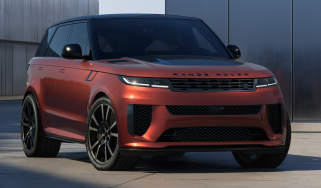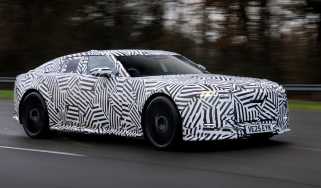Updated Range Rover Sport SV spotted – more aggression to match Aston Martin's DBX?
Dynamically impressive Range Rover Sport SV gets a few visual tweaks for its 2026 facelift
Flip to The Knowledge in an issue of evo and under the Range Rover Sport SV you’ll find ‘Hunts for apexes like a hot hatch’ as our positive summary of the top-dog performance SUV. Still, there’s always room for improvement, and from next year a facelifted version of the SV will freshen up the styling and hopefully address a few of the model’s shortcomings.
A revolution is unlikely; the current generation of Range Rover Sport will be on the market for a good few more years yet, so updates will be limited to a handful of external tweaks and as much as the chassis and powertrain engineers can get away with without any fundamental changes.
New spy shots suggest Range Rover hasn’t played around too much at the front end. Through the camouflage, the grille, headlights and vents all look very similar to those of the outgoing model, though the cooling channels on either side of the lower grille have gained an extra strake. The prominent bulging bonnet appears largely unchanged, and the camo’d car seems to be running around on a set of the 23-inch forged wheels already available on the SV.
Around the back, the differences are a little more obvious. Where previously there was a pair of dual-tip exhausts poking out either side of the rear valance, the SV now features a pair of large square-tipped pipes emerging from the centre of the diffuser-style element. They’re unlikely to emit the kind of noise that customers enjoyed (local residents less so) with the old Range Rover Sport SVR, due to emissions and drive-by regulations, but it should make the SV’s rear end look a lot more distinctive. Beyond that, the back otherwise appears similar to the existing car.
There probably won’t be significant changes to the powerplant. The BMW-sourced 4.4-litre twin-turbocharged V8 currently makes 625bhp and 590lb ft of torque, hauling the 2485kg SV from 0 to 62mph in 3.8 seconds. Why are we not likely to see more? Because in the outgoing car the engine is already butting up against the torque limit of the eight-speed ZF automatic, so without an all-new ‘box, there’s not much wiggle room.
A change to the car’s ‘6D Dynamics’ system is expected, though. Already capable of limiting roll (and, with the right tyres, generating up to 1.2 lateral g) and working with four-wheel steering for increased agility, we’re expecting the revised SV to be slightly more (or even more) playful, with more of a rear bias to its handling balance. This should bring it a little closer to performance SUV rivals such as the Aston Martin DBX, Lamborghini Urus and Ferrari Purosangue.
With no fundamental changes, however, it could be a good time to pick up the old model when the new one arrives next year. The SV currently starts at just over £150,000 brand new (a little more for the SV Black, and around £174,000 for the SV Carbon), but year-old cars are already dipping under £130,000 – and are still deeply impressive to drive. And if you’re after something a little (well, a lot) more brash, the older SVR starts at under £30,000…








